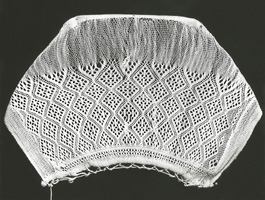Juraj Zajonc
Knitting is a group of techniques whereby the knit is made by crossing, twisting or intertwining loops by hand or with the aid of simple tools. A stitch is created by two methods. In the first, it is created from a group of parallel threads or fibres, which can be stretched as a warp. The second group are techniques where the stitch is created from a never-ending thread. Knitting from a group of threads is probably one of the oldest methods of creating textiles, and was the basis for knitting. This is shown, for example, by the methods of connecting stalks or plants into mats, knitting the bottoms of sieves from wooden twigs or their half-knitting (combining knitting and weaving) from phloem on a basic frame. The first textiles from fibres were also probably created in this way. Connecting three or four fibres into the shape of a plait was generally widespread and also known in Slovakia. A peculiarity is a method of making laces with flat or square crosscut, which was usually made by two persons. An older and specific technique of knitting from a group of threads is knitting on a small handloom, also called frame knitting. This technique created a flexible or patterned knit. Knitting on a handloom was not only known in Europe, but also in parts of Africa (for example in Egypt, Algeria), Asia (e.g. Persia, Afghanistan) as well as on the American continent (e.g. Mexico, Peru, Colombia), even though the basic working device was not always a frame. On the territory of Slovakia, two female items of clothing were made using this technique – hoods and belts, where the flexibility of the knit was an advantage when wearing the item. From knitting techniques using groups of threads, the widest, most variable and probably most documented technique in Europe was the technique of knitting with small bobbins on a frame – small cushion. Bobbin lacing is generally considered a European discovery, originating in the 15th century in renaissance Italy or Dalmatia. However, the oldest known discovery confirming the existence of this knitting technique is from Cyprus. Bobbin lacing spread to France, Belgium, Germany and other European countries from Italy. It reached Slovakia in the 16th – 17th century, mainly with colonisation by German miners. In the 17th to 19th centuries, elements of Spanish, Italian and Belgian laces spread to Slovakia, and the influence of Czech bobbin lacing was also very strong. At the end of the 19th and the first half of the 20th century, 17 mining and agricultural bobbin laces with their own character were gradually formed.
